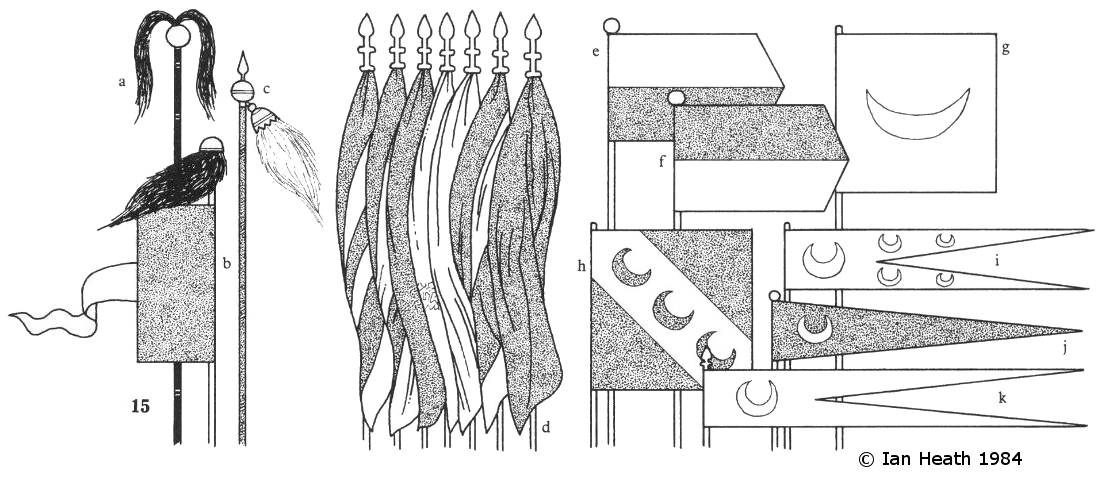
Shop Amazon - Create an Amazon Baby Registry
OTTOMAN FLAGS
An extract from Armies of the Middle Ages, Volume 2by Ian Heath



15. OTTOMAN FLAGS
The earliest Ottoman standard was the horse-tail or tug (Persian tuq), used to indicate the authority invested in a chieftain by the sultan according to legend the founder of the Ottoman dynasty, Othman, had himself been sent a tug by the Seljuk sultan Giyaseddin Masud II in 1289, confirming his authority as a frontier chieftain (uc bey). Under the Ottoman sultans the provincial governors or sancak beys had one horse-tail, beylerbeys and viziers had 2, chief viziers had 3, and the sultan had 4, or later 6. Those of the sultans were carried by Silihdars. 15a depicts an Ottoman horse-tail standard from a Turkish picture portraying the 1529 siege of Vienna; it is black, with a gold ball and gilt fittings on the staff. 15[c] is a 14th century Persian variant, with a white horse or yak tail and red staff but again with a gold ball and gilt fittings. With Persian standards the ball atop the staff was more usually silver, these being described as ‘full moons’ in a number of sources. 15[b] is also Persian, being a good example of the frequent combination of horse-tail and flag, in this instance a black horse-tail and a red banner with a dark green tail. Tamerlane’s army too carried horse-tail standards, his personal one at the Battle of Ankara, carried by his son Mohammed Sultan, governor of Samarkand, being surmounted by a crescent rather than a ball. Horse-tail standards were sometimes dyed, most often red. Those of the White Sheep and Black Sheep Turks, however, remained white and black respectively.
Konstantin Mihailovic has provided us with a brief but important description of the principal flags of the Porte in the 15th century, which he says numbered 4. He says: ‘One banner is white, inscribed with golden letters, and that banner is supreme, for it signifies that all the sultan’s power is there. It is called alamsandiak [probably Mihailovic is confusing alum, ‘bannner’, with ak sancak, ‘white banner’]. The second banner is red, and this one is the court cavalry’s. The third banner is green and red, the fourth is gold and red, and these are the Janissary court infantry’s. And when these 4 banners are unfurled, the sultan is there among his courtiers.’ It seems likely from this description that the group of 7 flags depicted in 15d, from the picture of the Battle of Mohacs already referred to under figure 13, represents the flags of the household cavalry with the sultan’s in the centre. There are 2 red flags (third and seventh from left) and 2 red and green striped flags (second and sixth from left), and since one of each appears on either side of the sultan’s white flag it seems possible that they are the banners of the Four Boluks. However, it is recorded by several authorities that it was the Sipahi-oghlans’ flag that was red, while those of the Four Boluks are listed by George Gush in Renaissance Armies as red and white, red and yellow, green, and white, the former 2 for the Ulufeciyan and the latter 2 for the Gureba; he also gives the Silihdars’ flag as yellow. The remaining 2 flags in the ms. pictures, however, are a striped red and yellow (or gold) one at the extreme left, and a green one to the immediate right of the sultan’s. As can be clearly seen, there are several discrepancies between this picture and the sources from which George Gush’s list was derived, and all that can be stated with any certainty is that this same group of 7 flags appears in the vicinity of the sultan in more than one 16th century Ottoman ms.
From the same picture, 15e and f are shown in the original accompanying the Janissaries and artillery. They are green over red and red over yellow/gold respectively, these colours tallying with Mihailovic’s description exactly. In addition each Janissary orta presumably carried its own individual banner, since the Encyclopaedia of Islam refers to each of them having ‘an emblem that was placed upon its flags’.
Mihailovic notes in addition that each beylerbey and sancak bey had his own banner ‘given by the sultan’, and it was surely these rather than their tug standards that gave the provincial governors their title of sancak bey, meaning ‘lord of the standard’. They are probably the innumerable flags charged with stars, horizontal and diagonal bands and, above all, crescents, that are to be found in most Western and Eastern mss. alike throughout the 15th-16th centuries. 15g-k show a selection of such flags. The colours of 15g, from the Zonchio woodcut, are unknown (it is left plain in the original), but of the others 15h is red with a white diagonal band and red crescents, while 15i, j and k are white, red and light green respectively, all with light blue crescents. Flags carried at the siege of Belgrade in 1456 were described by Sa’d ed-Din as ‘spangled banners, like flaming tulip beds’, an impression confirmed by ms. illustrations, which indicate that the predominant colours were red, blue, white and yellow or gold.